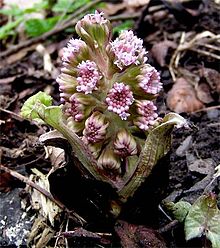Butterbur
| Petasites | |
|---|---|
 |
|
| Petasites hybridus | |
| Scientific classification | |
| Kingdom: | Plantae |
| (unranked): | Angiosperms |
| (unranked): | Eudicots |
| (unranked): | Asterids |
| Order: | Asterales |
| Family: | Asteraceae |
| Tribe: | Senecioneae |
| Genus: |
Petasites Mill. |
| Synonyms | |
|
Nardosmia Cass. |
|
Nardosmia Cass.
Petasites is a genus of flowering plants in the sunflower family, Asteraceae, that are commonly referred to as butterburs and coltsfoots. They are perennial plants with thick, creeping underground rhizomes and large rhubarb-like leaves during the growing season.
The short spikes of flowers are produced just before the leaves in late winter (e.g. Petasites fragrans or spring, emerging with only a few elongated basal bracts and are usually green, flesh coloured or dull white depending on the species.
Butterbur can be found in parts of Asia such as Korea, China, and Japan, as well as Europe and North America. They prefer moist environments such as riverbanks, marshes and ditches.
Petasites is closely related to the genera Tussilago and Senecio.
Butterbur has been used for over 2000 years to treat a variety of ailments including fever, lung disease, spasms, and pain. Currently, butterbur extract is used for migraine prevention and treatment of allergic rhinitis, which have the most evidence for its effectiveness. Some butterbur species contain the chemicals petasin and isopetasin which are believed to have potential benefits in treating migraines. High concentrations of petasin occur in both butterbur root and leaves, with the leaves containing lower levels of the toxic chemical. Butterbur extracts have been reported to be effective in reducing frequency and severity of migraine headaches. Several double-blind studies have shown that high doses of Petasites hybridus" extract, containing petasin and/or isopetasin, are effective both in preventing and in relieving migraine, with the best results in groups taking the higher dose of the supplement. Although mainly well-tolerated, the adverse effects of butterbur reported in clinical trials include mainly gastrointestinal problems, such as nausea, flatulence, and belching. The American Academy of Neurology and American Headache Society now endorse butterbur for preventing migraine headaches with a Level A recommendation (based on at least two strong clinical trials). Furthermore, the Canadian Headache Society supports a strong recommendation for use of butterbur in prevention of migraines for select patients based on their clinical features and co-existing disorders.
...
Wikipedia
